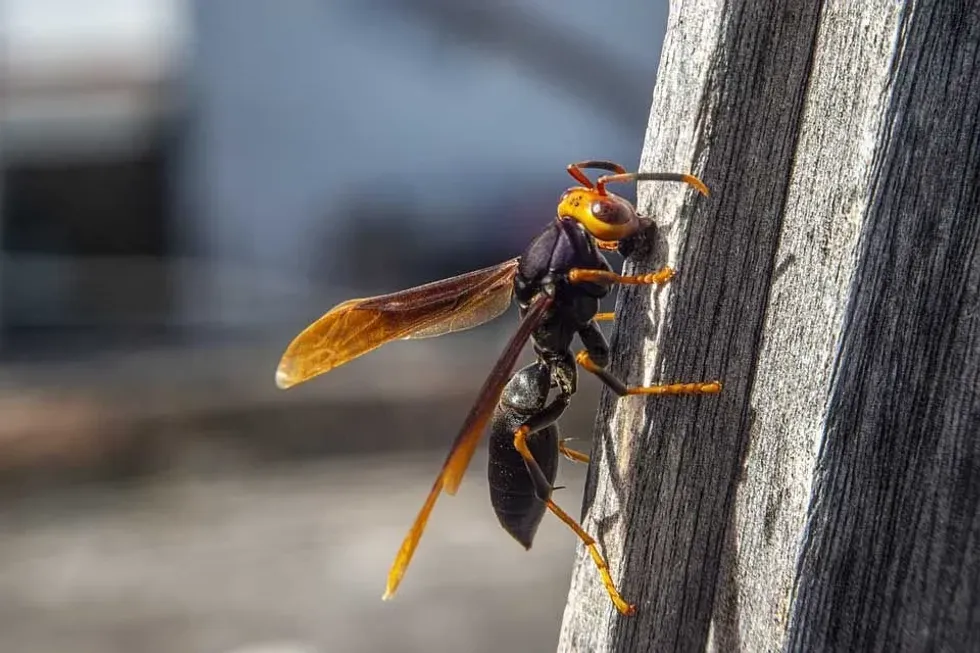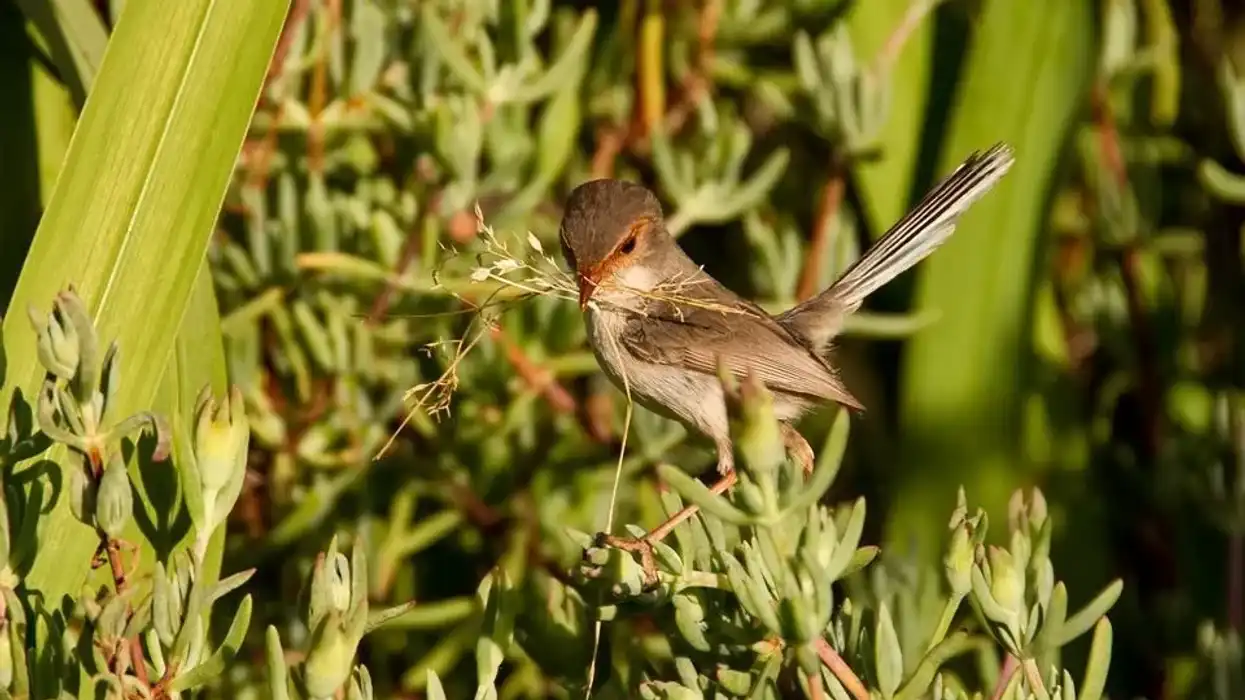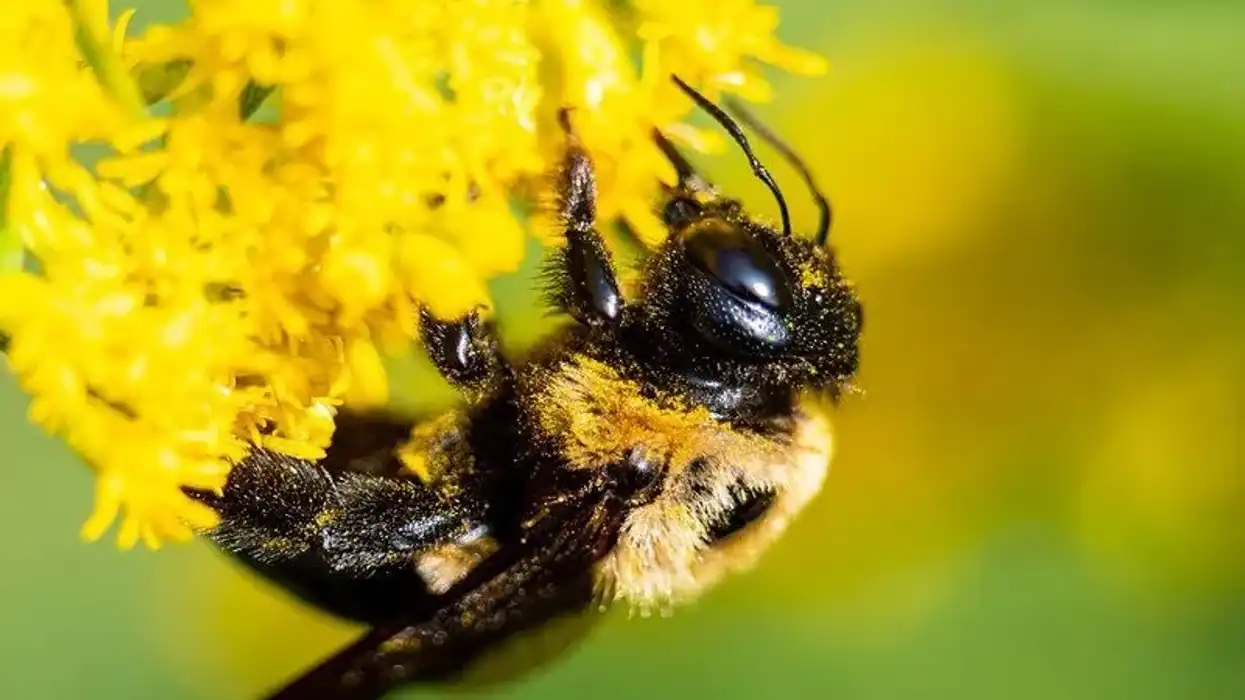Common wasp (scientific name vespula vulgaris) is commonly known as the common yellow jacket wasp or common paper wasp, owing to the black and yellow stripes that they have. The vespula germanica and vespula vulgaris are both known as the European wasp or the German wasp.
Their sociable behavior allows them to survive in multiple habitats. Common wasp (vespula vulgaris) build a tan paper nest wherever the nests could hold.
The queen wasps search for a depression wherein she can build her nest.
A colony cycle in common wasps lasts for a duration of 6-11 months and produces 3000 to 8000 larvae after its completion. Common wasps are also known as jaspers in some locations of Europe as these social wasps have striped abdomens resembling that of a jasper.
Common thread waisted wasp generally feeds on fruits to provide the larvae with sufficient carbohydrates. They can be differentiated from other social wasps due to the anchor shaped mark on their face.
Common wasps also feed on insects, spiders, and bees. While they exhibit many similar qualities to bees, there are actually many underlying differences between bees and wasps. If you want to know more about common wasp species, check out yellow jacket wasp facts and cicada killer wasp facts.
Common Wasp Interesting Facts
What type of animal is a common wasp?
A common wasp (class insecta) is an insect that is brown in color and has yellow or red stripes. The common wasp can sting a human being during warm seasons.
The sting of the common wasp is poisonous and may trigger redness and irritation. It can also cause further infections if the person, who is stung, is allergic to the venom.
What class of animal does a common wasp belong to?
The common wasp is an insect, which is omnivorous in nature. It is an omnivorous insect, and its abdomen is segregated into six segments with yellow and black stripes resembling the gemstone jasper. The only distinction between a European wasp and the German wasp is that the Vespula vulgaris lacks black spots on its head and back.
How many common wasps are there in the world?
The conservation status of common wasps is listed by the IUCN Red List as Least Concern. These social wasps are found everywhere in the United Kingdom and some parts of New Zealand, Australia, and India.
A rough estimate of 30,000 different species of common wasps was identified in the world. These range from having a bright coloration, different body sizes, and have venomous and non-venomous poisons. Some wasps don’t sting while some like the Paraponera Clavata cause excruciating pain and their sting is most painful.
Where does a common wasp live?
Common wasps can survive in multiple habitats like the woods, farms, tropical rainforests, forests, prairies, grasslands, shrublands, bushes, and even in artificial environments like gardens. These social wasps build nests made of mud and form vase-like structures.
Different species of the common wasp may be found in specific habitats. But they are eusocial vespids, and the common wasp sting can be painful at times.
What is a common wasp's habitat?
Common wasps can survive in multiple habitats like meadows, woodlands, and gardens and build nests that consist of colonies of approximately 10,000 adult workers. These workers forage the ground and collect food for the larvae.
The larvae are fed with insects while the wasp and the common wasp queen feeds on fruits or nectar. This social wasp likes to live and build the nest on the ground in hollow spaces which are made out of paper.
The common wasp nest resembles the shape of an umbrella and is made from wood pulp. This wood pulp is prepared from a dried papery substance that us made from chewed wood.
Who do common wasps live with?
Common wasps are very social and live together in a nest which comprises more than 10,000 adult workers. These are non-reproducing workers.
The first set of larvae is bigger in size as compared to the second set of larvae. Due to the decreased foraging activity of the queens, the second set does not receive much food, and also the larval period lengthens. This species also buzz loudly to scare away human beings and also sting when provoked.
How long does a common wasp live?
Common wasps do not need protein intake as these social wasps have a very short lifespan. The adult female workers live for 12-22 days, while the make adult workers or drones have a longer lifespan as compared to the females.
Common wasp queens can live for a year as she hibernates for a long time. The lifespan of the common wasps depends on the type of species it belongs to.
Common wasps can die when their nest is left exposed or when it is removed by an external force. Climatic conditions like extreme cold can also kill the common wasps.
How do they reproduce?
Eusocial vespids and solitary vespids reproduce in different ways. The common wasp is a eusocial insect and reproduces only once a year during the summer season.
After mating, the queen retreats into an enclosed space for hibernation till the end of winter and devotes to egg laying. During the spring season, the colonies of the fertilized female are formed.
Larvae start hatching out of these eggs and are fed insects by the females. Male adult workers that are born care for the larvae and sterile female adult workers provide assistance to the queen by foraging the ground for food to feed the young. As summer ends, male wasps hatch from the unfertilized eggs.
Female wasps grow from the larvae, which consume most food and become fertile. The males and females mate again to produce eggs, larvae, and adult workers.
What is their conservation status?
The conservation status of common wasps is of the least concern. They are 30,000 species of common wasps found in different locations of the globe. They are found in nests of more than 10,000 wasps while some species of the common wasps prefer living a solitary life.
Common Wasp Fun Facts
What do common wasps look like?
Common wasps have an outer shell that is brown in color, and stripes of black and yellow are found on their abdomen. The bright coloration of the common wasp is representative of their attacking nature.
They have six legs and have different physical appearances according to their species. These wasps have a yellow head with a black top along with a black thorax with yellow sides.
How cute are they?
Common wasps are vespids, and insects are not really cute, although they are small. These stinging wasps have an aggressive nature and will sting if provoked or irritated. The nest of common wasps should be removed with total care and protection as the whole colony tends to attack the intruder, and the victim is left with extreme pain.
How do they communicate?
Common wasps communicate to protect their homes or nests, which takes a long time to build. The common wasps communicate by releasing and smelling pheromones which are odorless to human beings.
These pheromones can suggest different things like type of food, mating, danger. The chemical droppings are also dangerous to other insects who try to invade the nest of the common wasp.
Recent studies also show a new way of communication in common wasps named gastral drumming. The common wasps beat their abdomen to communicate various things like impending danger, availability, and quality of food source.
How big is a common wasp?
A common wasp looks similar to a hornet and other vespids of the same kind. The adult workers are 0.48-0.70 in long, while the queen is around 0.80 in long.
The naked eye cannot distinguish between a male and a female wasp. These stinging wasps resemble bees, and if not observed closely, they might look the same. When you compare common wasp vs yellow jacket wasp, you will realize that the yellow jacket wasp is smaller than other wasp species but is more aggressive.
How fast can a common wasp fly?
The common wasp can fly at around seven miles per hour. The yellow jacket wasp can fly around at a speed of 6-30 miles per hour. While attacking, these stinging wasps buzz and fly along with their colonies and sting the intruder. Unlike bees, common wasps sting repeatedly.
How much does a common wasp weigh?
The weight of a common wasp depends on its type of species as some wasps tend to be larger in size. The average weight of the colony members including male and female adult workers is approximately the same but the weight of the queen is greater. The average weight of a common wasp is 10-19 g.
What are their male and female names of the species?
The male wasp is called a drone while the female wasp of the higher authority is called a queen which reproduces and hibernates. The queen lives along with the other members of the colonies. They are social insects and communicate in different ways to save wasp nests.
What would you call a baby common wasp?
The baby common wasps do not have a scientific name. They are simply called young or juveniles. The baby common wasps are fed by the sterile female workers as well as the queen. They are taken care of both by the males and the females.
What do they eat?
Common wasps feed on fruits and small insects. These stinging wasps also suck nectar from the flowers. They feed their young ones with insects. Common wasps are primarily insectivores and forage the ground to kill bees and spiders.
Are they dangerous?
Yes, some species of the common wasps can be dangerous as their venom can flair up allergies and cause infections to the human which is stung by them. These stinging wasps do sting repeatedly, and their sting can be really painful.
Would they make a good pet?
No, common wasps will not make a good pet as their lifespan is short, and they can better survive in the wild. These stinging wasps might even sting the owner and cause pain. They are vespids and should be let out in forests and woodland.
Did you know...
Common wasps invade honeycombs to gather honey. The sting of a common wasp can be benign to human beings, and the pain can wear off in less than 24 hours.
Allergic people can suffer from the sting of the common wasp from a shock known as an anaphylactic shock that can cause death. Male drones succumb to death after mating with the queen.
How many species of wasps are there?
Approximately 30,000 species of wasps are found all over the world. These wasp species have different traits, physical appearances, and venomous and non-venomous sting.
What is the difference between a female common wasp and a bee?
Most people often make a mistake of confusing bees with wasps but in realty there are many differences between bees and wasps. The female common wasp has a stinger called the ovipositor and can sting repeatedly while the female bee loses its stinger after attacking.
Female bees have a wide and hairy body, and stout legs, while the female common wasp has long legs and have narrow bodies as compared to bees.
The bees have a pointed lower abdomen and narrow waists as compared to wasps. Common wasps also compete with the honey bees for the honeydew that is secreted by the scale insect.
Here at Kidadl, we have carefully created lots of interesting family-friendly animal facts for everyone to discover! Learn more about some other arthropods including paper wasp, or mud dauber wasp.
You can even occupy yourself at home by drawing one on our Common Wasp coloring pages.










